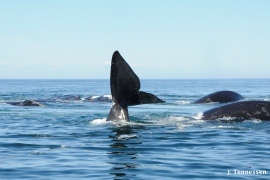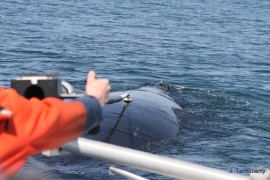Research in the lab is focused on answering questions related to the behavioral ecology, bioacoustics, and conservation of animals. These are the primary research areas in the lab. Please contact us for more information about current and upcoming research studies.
Acoustic Communication in Marine Mammals

Marine mammals have evolved to rely heavily on sound for survival. Sound plays a critical role in the biology of cetaceans, ranging from attracting and selecting mates to being able to sense the environment and find prey. Despite decades of research, the acoustic repertoire for many species remains poorly described, with many sounds recorded in the ocean coming from unknown species. The behavioral function is known only for a small subset of identified sounds produced by marine mammals. A major research focus in our group is to describe the acoustic repertoire of marine mammal species and determine the behavioral context of sound production. These data give us insight into the biology and behavior of these species and aid in conservation through improved passive acoustic monitoring.
Effects of Noise on Communication

Acoustic sources of noise are ubiquitous, both on land and underwater. Even remote wilderness areas experience natural noise sources generated from wind or precipitation. Our research focuses on noise induced vocal modifications in a variety of species to assess the ability of different species to compensate for noise in the environment. Studies focus on describing how animals modify their vocalizations in a variety of natural and anthropogenic noise regimes, whether these modifications are the result of behavioral plasticity, and whether vocal modifications improve the detectability of animal signals in particular types of noise. These data are crucial for characterizing the acoustic repertoires of species, which may change in different background noise conditions.
Baleen Whale Behavior

New technology has opened exciting new research areas in marine mammal science. Part of our research involves the attachment of archival recording tags with suction cups. These tags record the sounds that the animal makes, the sounds the animal hears, as well as a suite of sensors to document the movement patterns of the animal underwater. Analyses of these data provide new insight into the diving and foraging behaviors of these species. Additional studies rely on visual observations to describe surface behaviors of baleen whale species.
Evolution of Acoustic Signaling Systems

There is great diversity in the acoustic signals produced by animals, both in marine and terrestrial systems. Part of our research focuses on the factors that drive the shape of signals produced by different species. These include ongoing studies of propagation characteristics of different signal types in different habitats, studies of competition for acoustic space or climate conditions in the environment, and the impact of anthropogenic sound on the signaling behavior of different species.
Passive Acoustic Monitoring

Passive acoustic monitoring is a widely used technique to detect the presence of vocalizing animals in the environment. This technique allows for remote monitoring of vocal species and provides insight into seasonal and diel trends in behavior. Our focus is on describing the behavioral function of specific call types produced by species and determining whether there are trends in production over diel and seasonal time scales. These data are crucial to identifying the suitability of particular sound types for passive acoustic monitoring and to aid in interpretation of recordings.